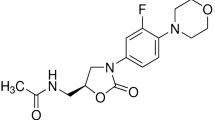Abstract
Saliva/blood and saliva/plasma concentration ratios were determined for sulfamethoxazole and trimethoprim following oral administration of cotrimoxazole to healthy human subjects. The mean experimentally determined saliva/plasma concentration ratios for sulfamethoxazole and trimethoprim were 0.0157 and 1.13, respectively. These values were shown to be in reasonable agreement with theoretical predictions. It was demonstrated that partitioning of drugs from saliva into the buccal must be considered in making theoretical predictions.
Similar content being viewed by others
References
L. F. Devine, R. C. Knowles, W. E. Pierce, R. O. Peckinpaugh, C. R. Hagerman, and R. I. Lytle. Proposed model for screening antimicrobial agents for potential use in eliminating meningococci from the nasopharynx of healthy carriers.Antimicrob. Agents Chemotherapy-1968, pp. 307–314 (published 1969).
P. D. Hoeprich. Prediction of antimeningococcic chemoprophylactic efficacy.J. Infect. Dis. 123:125–133 (1971).
M. E. Melish. Evaluation of the effectiveness of Bactrim (sulfamethoxazole and trimethoprim) in eradicating theH. influenzae type b nasopharyngeal carrier state in an epidemic situation. Unpublished manuscript.
A. S. E. Flowle. Aspects of the pharmacokinetic behavior of trimethoprim and sulfamethoxazole. In L. S. Bernstein and A. J. Salter (eds.),Trimethoprim/Sulphamethoxazole in Bacterial Infections, Wellcome Foundation Symposium, Int. Symp. Sardinia, April 26–27, 1972, Churchill Livingstone, Edinburgh, 1973, pp. 63–72.
A. A. Quayle and D. M. Hailey. Antimicrobial substances in saliva: Sulfamethoxazole and trimethoprim (co-trimoxazole).Br. J. Oral Surg. 11:60–65 (1973).
H. Beck. Etude pharmacokinétique des constituants du Bactrim chez les personnes âgées indemnes ou atteintes d'une insuffisance hépatique ou rénale.Rev. Med. 23:1437–1445 (1971).
I. Hansen, M. L. Nielsen, and S. Bertelsen. Trimethoprim in human saliva, bronchial secretion and lung tissue.Acta Pharmacol. Toxicol. 32:337–344 (1973).
T. A. Stamey, S. R. M. Bushby, and J. Bragonje. The concentration of trimethoprim in prostatic fluid: Nonionic transport or active transport?J. Infect. Dis. Suppl. 128:S686-S689 (1973).
G. W. Jordan, S. F. Krajden, P. D. Hoeprich, G. A. Wong, T. H. Pierce, and D. C. Rausch. Trimethoprim-sulfamethoxazole in chronic bronchitis.Can. Med. Asssoc. J. Suppl. 112:91S-95S (1975).
D. T. D. Hughes, A. Bye, and P. Hodder. Levels of trimethoprim and sulfamethoxazole in blood and sputum in relation to treatment of chest infections.Proc. 7th Int. Congr. Chemother. 1:1105–1106 (1971).
J. D. Salmon, A. S. E. Fowle, and A. Bye. Concentrations of trimethoprim and sulphamethoxazole in aqueous humor and plasma from regimens of co-trimoxazole in man.J. Antimicrob. Chemother. 1:205–211 (1975).
P. E. J. Pohjanpelto, T. J. Sarmela, and T. Raines. Penetration of trimethoprim and sulfamethoxazole into the aqueous humour.Br. J. Ophthalmol. 58:606–608 (1974).
S. A. Kaplan, R. E. Weinfeld, and T. L. Lee. Semiautomated spectrophotofluorometric determination of trimethoprim in biological fluids.J. Pharm. Sci. 62:1865–1870 (1973).
A. C. Bratton and E. K. Marshall. A new coupling component for sulfanilamide determination.J. Biol. Chem. 128:537–550 (1939).
S. A. Kaplan, R. E. Weinfeld, and C. W. Abruzzo. Biological availability and biological equivalence.Adv. Automated Anal. 2:405–411 (1970).
A. Wald. The fitting of straight lines if both variables are subject to error.Ann. Math. Stat. 11:284–300 (1940).
M. G. Kendall and A. Stuart.The Advanced Theory of Statistics, Chapter 29, Hafner, New York, 1961, pp. 375–418.
S. B. Matin, S. H. Wan, and J. H. Karam. Pharmacokinetics of tolbutamide: Prediction by concentration in saliva.Clin. Pharmacol. Ther. 16:1052–1058 (1974).
B. Rudy and B. Senkowski. Sulfamethoxazole. In K. Florey (ed.),Analytical Profiles of Drug Substances, Vol. 2, Academic Press, New York, 1973, pp. 467–486.
A. Bye, A. S. E. Fowle, and C. Pullin. Modifications of the absorption and excretion of trimethoprim and Sulphamethoxazole predicted from the buccal mucosa.Proc. 7th Int. Congr. Chemother. 1:27–28 (1971).
Author information
Authors and Affiliations
Rights and permissions
About this article
Cite this article
Eatman, F.B., Maggio, A.C., Pocelinko, R. et al. Blood and salivary concentrations of sulfamethoxazole and trimethoprim in man. Journal of Pharmacokinetics and Biopharmaceutics 5, 615–624 (1977). https://doi.org/10.1007/BF01059687
Received:
Revised:
Published:
Issue Date:
DOI: https://doi.org/10.1007/BF01059687




